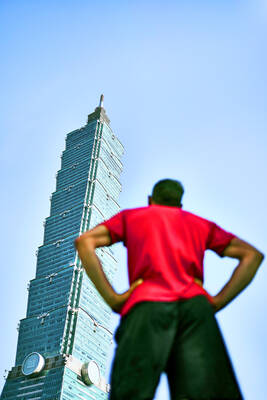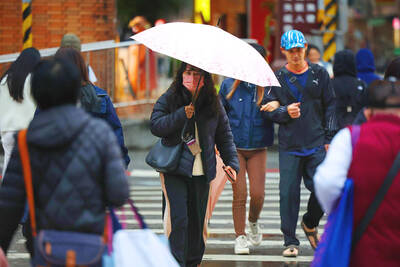A former Water Resources Agency (WRA) official's letter to a newspaper, which said that additional construction work on Shihmen Reservoir dam might damage the structure and cause it to collapse, sparking concerns about public safety and questions as to whether the dam is safe.
The letter was written by former WRA deputy director-general Wu Hsien-hsiung (吳憲雄), and was published in the Chinese-language newspaper China Times on Aug. 16. In the letter, Wu said that the additional construction -- huge water pipes and pumps on the top of the dam -- could damage the structure, make it leak and possibly even cause it to collapse. If that happened, water from the reservoir would flood most of Taoyuan and Taipei counties and more than 3.5 million residents in Taipei and Taoyuan counties could be killed within a few minutes.
"The entire process would take less than two hours," Wu said in his letter.
STRAIN
Wu said that ever since the dam was completed, officials have banned buses, trucks and other large vehicles with more than six wheels from using the road on top of the dam, due to concern that the structure could be damaged. Therefore, he wrote, he could not believe that officials would now put so much heavy additional construction work on the dam.
"One more major earthquake and the dam could collapse," he said.
Obviously, Wu's letter to the editor rattled the public, and sparked concerns about the safety of the dam. Even Premier Frank Hsieh (謝長廷) got involved in responding to the warning by the former government official, and asked water resource experts as well as engineers and architects to determine whether the dam posed a danger to the public.
"I think my former supervisor [Wu] must have misunderstood," said Lai Bo-hsun (
Lai said that the pumps are all situated on floating docks in the reservoir, and only pipes go through the top of the dam. He said that the vibration these pipes cause remains within a safe range, and the office has assigned experts to monitor any additional construction, as well as to inspect the structural integrity of the dam from time to time.
"There is no problem with it," he said.
However, despite such guarantees, Wu's concerns seem to have won the support of other water resource experts and engineers.
"I do not believe that there is any immediate danger from the dam or the possibility that it might collapse anytime soon. However, I do recommend that officials remove the additional construction work as soon as possible," said Lee Hong-yuan (
"So long as any construction was not included in the original design for the dam, it should be taken out, or it will definitely and gradually damage the main structure, sooner or later," Lee said.
In addition to potential damage to the dam, Lee also said that more maintenance work must be carried out to prolong the life of the reservoir.
According to the professor, due to its original design, water from the Shihmen Reservoir is definitely muddier than the water from other reservoirs. But the muddy water has not been a problem, because the Shihmen Reservoir was initially built for agricultural purposes. However, it has since become a main reservoir providing water supplies for daily use in Taoyuan and Taipei counties.
"In addition to regular maintenance work to clean up the mud in the reservoir, I think officials must pay attention to water and soil preservation in the upstream areas of the reservoir," he said.
According to the WRA, the Shihmen Reservoir was completed in 1964. Its maximum capacity is 340 million tonnes of water. In addition to the Shihmen Reservoir, there are 92 other reservoirs in Taiwan. There has been no record of a dam collapse in Taiwan's history. However, there have been examples of dams collapsing because of heavy rains brought by typhoons in modern history.
For example, a typhoon that formed near Guam in July 1975 swept through Taiwan then touched down in China -- the country with the most reservoirs in the world -- bringing a downpour of approximately 800mm in a day in Henan Province. The downpour caused dams to collapse in the Panchiao Reservoir and Shihmantan Reservoir. Information from the Chinese government stated that the collapse of the two dams killed less than 10,000 residents. However, Western news agencies reported that nearly 230,000 people were killed and more than 6.8 million houses were leveled.
OTHER ISSUES
In addition to the public concerns surrounding the safety of the dam, Liu Chao-min (
According to him, to build a reservoir will have several adverse effects, including: Reducing the natural water-supply from a river in its downstream areas; the weight of the water in a reservoir is likely to trigger more earthquake activities if the reservoir is built on a fault; building a reservoir will force thousands of local residents to relocate, which costs a lot of money; building a reservoir will definitely change the natural appearance and damage the natural environment, and some of that damage may be irreversible.
"We need alternative ways to solve our water-shortage problems instead of just building more reservoirs and devastating our natural environment," Liu said.

US climber Alex Honnold is to attempt to scale Taipei 101 without a rope and harness in a live Netflix special on Jan. 24, the streaming platform announced on Wednesday. Accounting for the time difference, the two-hour broadcast of Honnold’s climb, called Skyscraper Live, is to air on Jan. 23 in the US, Netflix said in a statement. Honnold, 40, was the first person ever to free solo climb the 900m El Capitan rock formation in Yosemite National Park — a feat that was recorded and later made into the 2018 documentary film Free Solo. Netflix previewed Skyscraper Live in October, after videos

Starting on Jan. 1, YouBike riders must have insurance to use the service, and a six-month trial of NT$5 coupons under certain conditions would be implemented to balance bike shortages, a joint statement from transportation departments across Taipei, New Taipei City and Taoyuan announced yesterday. The rental bike system operator said that coupons would be offered to riders to rent bikes from full stations, for riders who take out an electric-assisted bike from a full station, and for riders who return a bike to an empty station. All riders with YouBike accounts are automatically eligible for the program, and each membership account

NUMBERS IMBALANCE: More than 4 million Taiwanese have visited China this year, while only about half a million Chinese have visited here Beijing has yet to respond to Taiwan’s requests for negotiation over matters related to the recovery of cross-strait tourism, the Tourism Administration said yesterday. Taiwan’s tourism authority issued the statement after Chinese-language daily the China Times reported yesterday that the government’s policy of banning group tours to China does not stop Taiwanese from visiting the country. As of October, more than 4.2 million had traveled to China this year, exceeding last year. Beijing estimated the number of Taiwanese tourists in China could reach 4.5 million this year. By contrast, only 500,000 Chinese tourists are expected in Taiwan, the report said. The report

Temperatures are forecast to drop steadily as a continental cold air mass moves across Taiwan, with some areas also likely to see heavy rainfall, the Central Weather Administration (CWA) said. From today through early tomorrow, a cold air mass would keep temperatures low across central and northern Taiwan, and the eastern half of Taiwan proper, with isolated brief showers forecast along Keelung’s north coast, Taipei and New Taipei City’s mountainous areas and eastern Taiwan, it said. Lows of 11°C to 15°C are forecast in central and northern Taiwan, Yilan County, and the outlying Kinmen and Lienchiang (Matsu) counties, and 14°C to 17°C